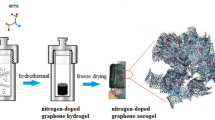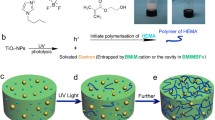Abstract
Electrochemical actuators based on conductive polymers are emerging as a strong competitive in the field of soft actuators because of their intrinsically conformable/elastic nature, low cost, low operating voltage and air-working ability. Recent development has shown that adding electroactive materials, such as CNT and graphene, can improve their actuation performance. Despite the complex material systems used, their output strains (one of the key factors) are generally lower than 1%, which limited further applications of them in multiple scenarios. Here, we report soft electrochemical actuators based on conductive polymer ionogels by embedding polyaniline particles between the PEDOT:PSS nanosheets. Results show that such a hierarchical structure not only leads to a high conductivity (1250 S/cm) but also improved electrochemical activities. At a low operating voltage of 1 V, the maximum strain of these soft actuators reaches an exceptional value of 1.5%, with a high blocking force of 1.3 mN. Using these high-performance electrochemical actuators, we demonstrate soft grippers for manipulating object and a bionic flower stimulated by an electrical signal. This work sets an important step towards enabling the enhanced performance of electrochemical actuators based on conductive polymers with designed microstructures.








Similar content being viewed by others
Data Availability
The datasets generated during the current study are available from the corresponding author on reasonable request.
References
Majidi, C. (2014). Soft robotics: A perspective-current trends and prospects for the future. Soft Robotics, 1, 5–11. https://doi.org/10.1089/soro.2013.0001
Lee, C., Kim, M., Kim, Y. J., Hong, N., Ryu, S., Kim, H. J., & Kim, S. (2017). Soft robot review. International Journal of Control Automation and Systems, 15, 3–15. https://doi.org/10.1007/s12555-016-0462-3
Li, M., Pal, A., Aghakhani, A., Pena-Francesch, A., & Sitti, M. (2022). Soft actuators for real-world applications. Nature Reviews Materials, 7, 235–249. https://doi.org/10.1038/s41578-021-00389-7
Miriyev, A., Stack, K., & Lipson, H. (2017). Soft material for soft actuators. Nature Communications, 8, 596. https://doi.org/10.1038/s41467-017-00685-3
Kim, J., Kim, J. W., Kim, H. C., Zhai, L. D., Ko, H. U., & Muthoka, R. M. (2019). Review of soft actuator materials. International Journal of Precision Engineering and Manufacturing, 20, 2221–2241. https://doi.org/10.1007/s12541-019-00255-1
Namdar Ghalati, M. H., Akbari, S., Ghafarirad, H., & Zareinejad, M. (2023). Behavior analysis of biomimetic soft bending actuators in free motion and contact. Journal of Bionic Engineering, 20, 967–981. https://doi.org/10.1007/s42235-022-00322-w
Mirfakhrai, T., Madden, J. D. W., & Baughman, R. H. (2007). Polymer artificial muscles. Materials Today, 10, 30–38. https://doi.org/10.1016/S1369-7021(07)70048-2
Baughman, R. H. (1996). Conducting polymer artificial muscles. Synthetic Metals, 78, 339–353. https://doi.org/10.1016/0379-6779(96)80158-5
Mirvakili, S. M., & Hunter, I. W. (2018). Artificial muscles: Mechanisms, applications, and challenges. Advanced Materials, 30, 1704407. https://doi.org/10.1002/adma.201704407
Wang, J. X., Gao, D. C., & Lee, P. S. (2021). Recent progress in artificial muscles for interactive soft robotics. Advanced Materials, 33, 2003088. https://doi.org/10.1002/adma.202003088
Kim, O., Kim, S. J., & Park, M. J. (2018). Low-voltage-driven soft actuators. Chemical Communications, 54, 4895–4904. https://doi.org/10.1039/c8cc01670d
He, Q. S., Yin, G. X., Vokoun, D., Shen, Q., Lu, J., Liu, X. F., Xu, X. R., Yu, M., & Dai, Z. D. (2022). Review on improvement, modeling, and application of ionic polymer metal composite artificial muscle. Journal of Bionic Engineering, 19, 279–298. https://doi.org/10.1007/s42235-022-00153-9
Baughman, R. H., Shacklette, L. W., Elsenbaumer, R. L., Plichta, E., Becht, C. Conducting polymer electromechanical actuators. In: Brédas, J. L., Chance, R. R. Conjugated polymeric materials: Opportunities in electronics, optoelectronics, and molecular electronics. Springer Netherlands, pp 559–582 (1990).
Park, J. M., Kim, S. J., Jang, J. H., Wang, Z. J., Kim, P. G., Yoon, D. J., Kim, J., Hansen, G., & Devries, K. L. (2008). Actuation of electrochemical, electro-magnetic, and electro-active actuators for carbon nanofiber and ni nanowire reinforced polymer composites. Composites Part B-Engineering, 39, 1161–1169. https://doi.org/10.1016/j.compositesb.2008.03.009
Malinauskas, A., Malinauskiene, J., & Ramanavicius, A. (2005). Conducting polymer-based nanostructurized materials: Electrochemical aspects. Nanotechnology, 16, R51–R62. https://doi.org/10.1088/0957-4484/16/10/R01
Zhang, X., Wang, T. F., Li, S. J., & Shen, X. J. (2021). Electrodeposition polyaniline nanofiber on the PEDOT:PSS-coated sinws for high performance supercapacitors. Journal of Inorganic and Organometallic Polymers and Materials, 31, 4260–4271. https://doi.org/10.1007/s10904-021-02036-8
Hu, F. Q., Xue, Y., Xu, J. K., & Lu, B. Y. (2019). PEDOT-based conducting polymer actuators. Front Robot AI, 6, 114. https://doi.org/10.3389/frobt.2019.00114
Park, J., Lee, A., Yim, Y., & Han, E. (2011). Electrical and thermal properties of PEDOT:PSS films doped with carbon nanotubes. Synthetic Metals, 161, 523–527. https://doi.org/10.1016/j.synthmet.2011.01.006
Terasawa, N., & Asaka, K. (2016). High-performance PEDOT:PSS/single-walled carbon nanotube/ionic liquid actuators combining electrostatic double-layer and faradaic capacitors. Langmuir, 32, 7210–7218. https://doi.org/10.1021/acs.langmuir.6b01148
Wang, D. X., Lu, C., Zhao, J. J., Han, S., Wu, M. H., & Chen, W. (2017). High energy conversion efficiency conducting polymer actuators based on PEDOT:PSS/mwcnts composite electrode. RSC Advances, 7, 31264–31271. https://doi.org/10.1039/c7ra05469f
Jia, G. W., Zheng, A., Wang, X., Zhang, L., Li, L., Li, C. X., Zhang, Y., & Cao, L. Y. (2021). Flexible, biocompatible and highly conductive mxene-graphene oxide film for smart actuator and humidity sensor. Sensors and Actuators B: Chemical, 346, 130507. https://doi.org/10.1016/j.snb.2021.130507
Sachyani, E., Layani, M., Tibi, G., Avidan, T., Degani, A., & Magdassi, S. (2017). Enhanced movement of cnt-based actuators by a three-layered structure with controlled resistivity. Sensors and Actuators B: Chemical, 252, 1071–1077. https://doi.org/10.1016/j.snb.2017.06.104
Yano, H., Kudo, K., Marumo, K., & Okuzaki, H. (2019). Fully soluble self-doped poly(3,4-ethylenedioxythiophene) with an electrical conductivity greater than 1000 s cm−1. Science Advances, 5, eaav9492. https://doi.org/10.1126/sciadv.aav9492
Guo, D. J., Wang, L., Wang, X. J., Xiao, Y. A., Wang, C. D., Chen, L. M., & Ding, Y. H. (2020). PEDOT coating enhanced electromechanical performances and prolonged stable working time of ipmc actuator. Sensors and Actuators B: Chemical, 305, 127488. https://doi.org/10.1016/j.snb.2019.127488
Wang, Y., Zhu, C. X., Pfattner, R., Yan, H. P., Jin, L. H., Chen, S. C., Molina-Lopez, F., Lissel, F., Liu, J., Rabiah, N. I., Chen, Z., Chung, J. W., Linder, C., Toney, M. F., Murmann, B., & Bao, Z. (2017). A highly stretchable, transparent, and conductive polymer. Science Advances, 3, e1602076. https://doi.org/10.1126/sciadv.1602076
Pal, R., Goyal, S. L., Rawal, I., Gupta, A. K., & Ruchi. (2021). Efficient energy storage performance of electrochemical supercapacitors based on polyaniline/graphene nanocomposite electrodes. Journal of Physics and Chemistry of Solids, 154, 110057. https://doi.org/10.1016/j.jpcs.2021.110057
Yemata, T. A., Zheng, Y., Kyaw, A. K. K., Wang, X. Z., Song, J., Chin, W. S., & Xu, J. W. (2020). Binary treatment of PDEDOT:PSS films with nitric acid and imidazolium-based ionic liquids to improve the thermoelectric properties. Materials Advances, 1, 3233–3242. https://doi.org/10.1039/d0ma00522c
Petroffe, G., Beouch, L., Cantin, S., Aubert, P. H., Plesse, C., Dudon, J. P., Vidal, F., & Chevrot, C. (2018). Investigations of ionic liquids on the infrared electroreflective properties of poly(3,4-ethylenedioxythiophene). Solar Energy Materials and Solar Cells, 177, 23–31. https://doi.org/10.1016/J.SOLMAT.2017.07.018
Umrao, S., Tabassian, R., Kim, J., Nguyen, V., Zhou, Q. T., Nam, S., & Oh, I. K. (2019). Mxene artificial muscles based on ionically cross-linked Ti3C2Tx electrode for kinetic soft robotics. Science Robotics, 4, eaaw7797. https://doi.org/10.1126/scirobotics.aaw7797
Lu, W., Fadeev, A. G., Qi, B., Smela, E., Mattes, B. R., Ding, J., Spinks, G. M., Mazurkiewicz, J., Zhou, D., Wallace, G. G., Macfarlane, D. R., Forsyth, S. A., & Forsyth, M. (2002). Use of ionic liquids for pi-conjugated polymer electrochemical devices. Science, 297, 983–987. https://doi.org/10.1126/science.1072651
Lu, W., Norris, I. D., & Mattes, B. R. (2005). Electrochemical actuator devices based on polyaniline yarns and ionic liquid electrolytes. Australian Journal of Chemistry, 58, 263–269. https://doi.org/10.1071/ch04255
Li, Y. C., Tanigawa, R., & Okuzaki, H. (2014). Soft and flexible PEDOT/PSS films for applications to soft actuators. Smart Materials and Structures, 23, 074010. https://doi.org/10.1088/0964-1726/23/7/074010
Okuzaki, H., Takagi, S., Hishiki, F., & Tanigawa, R. (2014). Ionic liquid/polyurethane/PEDOT:PSS composites for electro-active polymer actuators. Sensors and Actuators B-Chemical, 194, 59–63. https://doi.org/10.1016/J.SNB.2013.12.059
Terasawa, N., & Asaka, K. (2018). Self-standing cellulose nanofiber/poly(3,4-ethylenedioxythiophene):Poly(4-styrenesulfonate)/ionic liquid actuators with superior performance. RSC Advances, 8, 33149–33155. https://doi.org/10.1039/c8ra06981f
Terasawa, N., & Asaka, K. (2018). Performance enhancement of PEDOT: Poly(4-styrenesulfonate) actuators by using ethylene glycol. RSC Advances, 8, 17732–17738. https://doi.org/10.1039/c8ra02714e
Bar-Cohen, Y., Simaite, A., Tondu, B., Mathieu, F., Souéres, P., & Bergaud, C. (2015). Simple casting based fabrication of PEDOT:PSS-PVDF-ionic liquid soft actuators. Electroactive Polymer Actuators and Devices (EAPAD). https://doi.org/10.1117/12.2083936
Rohtlaid, K., Nguyen, G. T. M., Soyer, C., Cattan, E., Vidal, F., & Plesse, C. (2019). Poly(3,4-ethylenedioxythiophene):Poly(styrene sulfonate)/polyethylene oxide electrodes with improved electrical and electrochemical properties for soft microactuators and microsensors. Advanced Electronic Materials, 5, 1800948. https://doi.org/10.1002/aelm.201800948
Lu, F. Z., Chen, T., Xiang, K., & Wang, Y. N. (2020). Ionic electro-active polymer actuator based on cobalt-containing nitrogen-doped carbon/conducting polymer soft electrode. Polymer Testing, 84, 106413. https://doi.org/10.1016/j.polymertesting.2020.106413
Acknowledgements
This work was supported by China Postdoctoral Science Foundation (2022M711372), Postdoctoral Research Program of Jiangsu Province (2021K544C) and the General Program of Natural Science Foundation for Higher Education in Jiangsu Province (21KJB510004); G. Cheng acknowledges the support from young & middle-aged academic leaders of Jiangsu Blue Project and Jiangsu 333 talent fund; L. Xu acknowledges the support from National Natural Science Foundation of China (NSFC No.51905222) and Natural Science Foundation of Jiangsu Province (Grant No. BK20211068). This work was also supported by International Science and Technology Cooperation Project in Zhenjiang City (Grant No: GJ2020009)
Author information
Authors and Affiliations
Contributions
HH: Conceptualization, investigation, data curation, formal analysis, writing—original draft. SZ: Methodology, formal analysis. YL: Characterization, data collection. XH: Investigation, data curation, formal analysis. LX: Investigation, data curation, formal analysis. AF: Conceptualization, investigation, project administration, funding acquisition. GC: Supervision, writing—review and editing. JD: Conceptualization, supervision.
Corresponding authors
Ethics declarations
Conflict of interest
The authors declare that they have no known competing financial interests or personal relationships that could have appeared to influence the work reported in this paper.
Additional information
Publisher's Note
Springer Nature remains neutral with regard to jurisdictional claims in published maps and institutional affiliations.
Supplementary Information
Below is the link to the electronic supplementary material.
Supplementary file2 (MP4 2940 KB)
Supplementary file3 (MP4 1773 KB)
Rights and permissions
Springer Nature or its licensor (e.g. a society or other partner) holds exclusive rights to this article under a publishing agreement with the author(s) or other rightsholder(s); author self-archiving of the accepted manuscript version of this article is solely governed by the terms of such publishing agreement and applicable law.
About this article
Cite this article
Hu, H., Zhang, S., Li, Y. et al. High Performance Soft Electrochemical Actuators Based on Hierarchical Conductive Polymer Ionogels. J Bionic Eng 20, 2755–2763 (2023). https://doi.org/10.1007/s42235-023-00401-6
Received:
Revised:
Accepted:
Published:
Issue Date:
DOI: https://doi.org/10.1007/s42235-023-00401-6




